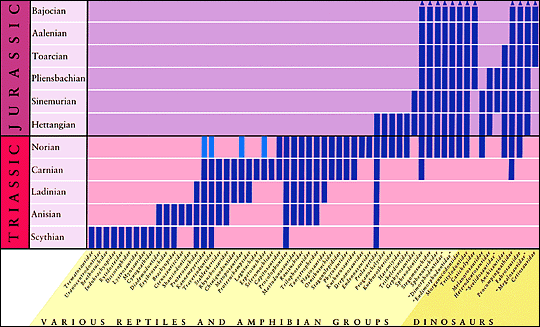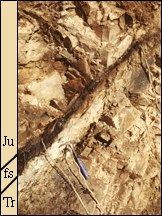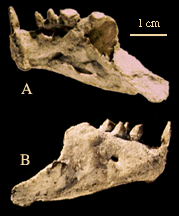3.4.3. Triassic-Jurassic Boundary
Hans-Dieter Sues, Royal Ontario Museum, Toronto, ON M5S 2C6,
Canada
The Triassic-Jurassic boundary is marked by a major extinction
in the marine realm. This event, one of the five largest extinctions during
the Phanerozoic Eon, is especially well documented in the European Alps,
where there are massive losses of species of bivalves and gastropods. Ammonoid
cephalopods almost became extinct. It has often been suggested that there
was also a major biotic crisis in the continental realm. The Late Triassic
is characterized by the appearance in the fossil record of many of the
"modern" clades of continental tetrapods (dinosaurs, mammals, turtles,
lepidosaurs, frogs and salamanders) or their proximate sister-taxa, which
then co-existed with various groups persisting from earlier stages of the
Triassic (such as crurotarsan archosaurs) or even the preceding Permian
period (such as various taxa of therapsids). Near or at the Triassic-Jurassic
boundary, the latter disappeared or experienced major losses in diversity.
Surprisingly, dinosaurs did not show any losses of lineages at this transition
(Fig. 3.4.3.1). Among pollen and spores of terrestrial plants, there was
a dramatic change from high-diversity palynofloras to assemblages almost
entirely made up of cheirolepidaceous conifers (Corollina or Classopollis).

Figure 3.4.3.1 (above): Ranges of families tetrapods through
the Triassic and Early Jurassic depicted at the stage level. The darker
blue bars ranges are from Olsen (1986) and the lighter blue bars are range
extensions since that time. Note that the largest concentrations of extinctions
occurs at the Triassic-Jurassic boundary. [Note: Rhaetian is her included
with the Norian]. Click on the image for a higher resolution figue.
| Currently, a major obstacle to analyzing the extinction
event on land is the virtual absence of detailed studies of continuous
sequences of continental strata ranging from the Norian-Rhaetian to the
basal Jurassic. For example, in the Germanic Basin, the continental strata
of the Late Triassic (Norian-Rhaetian) are overlain by marine rocks of
the Liassic transgression. At present, the best prospects for tracing the
biotic changes in continental settings are offered by the well-dated strata
of the Newark Supergroup and in Greenland. A recently discovered tetrapod
assemblage from the Jacksonwald syncline of the Newark basin in Pennsylvania
appears to predate the palynologically identifiable Triassic-Jurassic boundary
(Fig. 3.4.3.2) by only 800,000 years (Olsen et al., in prep.) (Fig. 3.4.3.3). |

|
Figure 3.4.3.2 (right): Palynologically identified Triassic-Jurassic
boundary exposed in the Jacksonwald syncline of the Newark basin about
10 m below the lowest CAMP basalt (Orange Mountain Basalt). A thin coal
or carbonaceous shale containing virtually only fern spores (fs, fern spike)
separates strata with typical Late Triassic (Tr) from typical Early Jurassic
(Ju) pollen and spore assemblages (Fowell et al., 1993). |
|
 |
What is to be done? First, we need to establish the pattern
of biotic change in continental settings on a much finer temporal and geographic
scale. This requires the identification and systematic study of additional
continuous, fossiliferous sequences of continental strata. Second, we need
to correlate any changes in continental biotas with the well-established
biotic crisis in marine communities. Magnetostratigraphy now offers a powerful
tool for such correlations. Are the observed biotic changes synchronous?
Are they worldwide in scope or is there a geographic pattern? Only after
addressing these questions will it become meaningful to look for potential
causes for the biological changes (climatic changes, large-scale volcanism
[CAMP], or bolide impact). |
| Figure 3.2.3.3 (left): Lower jaw of procolophonid reptile Hypsognathus
fenneri shown in medial (A) and lateral (B) views. From the Jacksonwald
syncline, about 800 ky older than the Triassic-Jurassic boundary.
This is a representative of a typical Triassic family of reptiles. |
|

